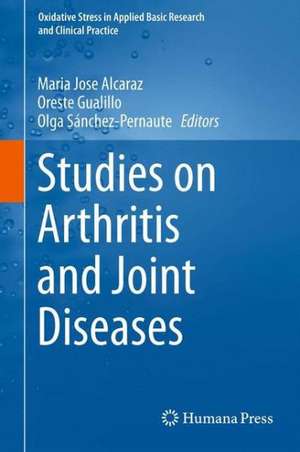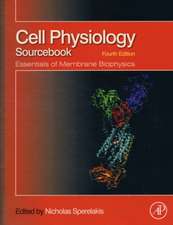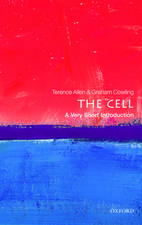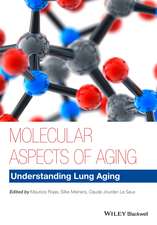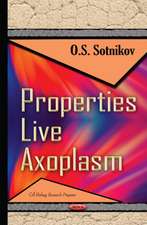Studies on Arthritis and Joint Disorders: Oxidative Stress in Applied Basic Research and Clinical Practice
Editat de Maria Jose Alcaraz, Oreste Gualillo, Olga Sánchez-Pernauteen Limba Engleză Hardback – 20 feb 2013
| Toate formatele și edițiile | Preț | Express |
|---|---|---|
| Paperback (1) | 1005.11 lei 6-8 săpt. | |
| Springer – 6 mar 2015 | 1005.11 lei 6-8 săpt. | |
| Hardback (1) | 1225.94 lei 6-8 săpt. | |
| Springer – 20 feb 2013 | 1225.94 lei 6-8 săpt. |
Din seria Oxidative Stress in Applied Basic Research and Clinical Practice
- 5%
 Preț: 1483.21 lei
Preț: 1483.21 lei - 18%
 Preț: 1272.98 lei
Preț: 1272.98 lei - 18%
 Preț: 1007.65 lei
Preț: 1007.65 lei - 18%
 Preț: 1843.73 lei
Preț: 1843.73 lei - 18%
 Preț: 1667.12 lei
Preț: 1667.12 lei - 18%
 Preț: 1242.52 lei
Preț: 1242.52 lei - 15%
 Preț: 695.70 lei
Preț: 695.70 lei - 15%
 Preț: 700.94 lei
Preț: 700.94 lei - 18%
 Preț: 1235.43 lei
Preț: 1235.43 lei - 18%
 Preț: 1560.73 lei
Preț: 1560.73 lei - 18%
 Preț: 951.29 lei
Preț: 951.29 lei - 18%
 Preț: 959.98 lei
Preț: 959.98 lei - 18%
 Preț: 953.65 lei
Preț: 953.65 lei - 18%
 Preț: 965.97 lei
Preț: 965.97 lei - 18%
 Preț: 966.27 lei
Preț: 966.27 lei - 18%
 Preț: 958.07 lei
Preț: 958.07 lei - 15%
 Preț: 654.95 lei
Preț: 654.95 lei - 18%
 Preț: 954.45 lei
Preț: 954.45 lei - 18%
 Preț: 961.41 lei
Preț: 961.41 lei - 18%
 Preț: 962.18 lei
Preț: 962.18 lei - 24%
 Preț: 826.78 lei
Preț: 826.78 lei - 20%
 Preț: 562.86 lei
Preț: 562.86 lei - 18%
 Preț: 1243.46 lei
Preț: 1243.46 lei - 18%
 Preț: 1010.96 lei
Preț: 1010.96 lei
Preț: 1225.94 lei
Preț vechi: 1495.04 lei
-18% Nou
Puncte Express: 1839
Preț estimativ în valută:
234.66€ • 254.98$ • 197.24£
234.66€ • 254.98$ • 197.24£
Carte tipărită la comandă
Livrare economică 21 aprilie-05 mai
Preluare comenzi: 021 569.72.76
Specificații
ISBN-13: 9781461461654
ISBN-10: 1461461650
Pagini: 428
Ilustrații: XII, 411 p. 41 illus., 15 illus. in color.
Dimensiuni: 155 x 235 x 27 mm
Greutate: 0.68 kg
Ediția:2013
Editura: Springer
Colecția Humana
Seria Oxidative Stress in Applied Basic Research and Clinical Practice
Locul publicării:New York, NY, United States
ISBN-10: 1461461650
Pagini: 428
Ilustrații: XII, 411 p. 41 illus., 15 illus. in color.
Dimensiuni: 155 x 235 x 27 mm
Greutate: 0.68 kg
Ediția:2013
Editura: Springer
Colecția Humana
Seria Oxidative Stress in Applied Basic Research and Clinical Practice
Locul publicării:New York, NY, United States
Public țintă
Professional/practitionerCuprins
Biomarkers of oxidative stress in joint diseases.- Regulation of T-cell functions by oxidative stress.- Nitric oxide and the respiratory chain in synovial cells and chondrocytes.- Adipokines, molecular players at the crossroad between inflammation and oxidative stress. Role in arthropathies.- Regulation of cartilage and bone metabolism by oxidative stress.- Role of oxidative stress in bone aging.- Genetic Component of Oxidative Stress in Rheumatoid Arthritis.- Oxidative stress in rheumatoid arthritis.- Oxidative stress and premature atherosclerosis in RA.- Role of Oxidative Stress and Reactive Oxygen Radicals in the Pathogenesis of Systemic Sclerosis.- Antioxidant and anti-inflammatory properties of heme oxygenase-1 in osteoarthritic articular cells.- Oxidative stress at the crossroads between osteoarthritis and metabolic syndrome.- Metabolic syndrome and gout.- Natural Antioxidants in the pharmacological treatment of rheumatic immune and inflammatory diseases.- Antioxidants inthe treatment of osteoarthritis and bone mineral loss.- Anti-cytokine agents to combat oxidative stress.- Oxidative Conditioning and treatment for Osteoarthritis.- The role of sirtuins in arthritis.- MicroRNA molecules, master regulators, biomarkers and potential therapies.- Estrogen-dependent transcriptional activity, a protection against ROS in osteoarthritis.
Recenzii
From the reviews:
“This is a thorough overview of the role of oxidative damage in joint and connective tissue disease. This is a highly specialized area that is important for rheumatologists as well as for basic scientists to understand. … book is appropriate for all practitioners and academicians who are interested in the role of oxidative damage in joint disorders. … The authors do a great job of connecting basic science concepts with clinical disease. … easy to read, and diagrams and charts are clear and used appropriately.” (Jonathan Miner, Doody’s Book Reviews, July, 2013)
“This is a thorough overview of the role of oxidative damage in joint and connective tissue disease. This is a highly specialized area that is important for rheumatologists as well as for basic scientists to understand. … book is appropriate for all practitioners and academicians who are interested in the role of oxidative damage in joint disorders. … The authors do a great job of connecting basic science concepts with clinical disease. … easy to read, and diagrams and charts are clear and used appropriately.” (Jonathan Miner, Doody’s Book Reviews, July, 2013)
Notă biografică
María José Alcaraz, Ph.D., is a full Professor in Pharmacology at the Department of Pharmacology, University of Valencia, Spain, and former Head of this Department. After completing her Ph.D. at the University of Valencia with Extraordinary Award, she undertook postdoctoral research funded by the Spanish Ministery of Education at the Department of Pharmacology, King's Col. London (1983-1984). She also worked as a visiting researcher at the Unité 348 INSERM, Paris (1998) and received the Dr. Esteve Foundation Award to the best publication in pharmacology and Almirall Award to the best project in pharmacology. In addition to act as editor or referee for several international journals and expert for scientific projects evaluation in different countries and international organizations, she has played an active role in international cooperation with Latin America. Maria José Alcaraz is the head of the “Pharmacology of Inflammation” group, Department of Pharmacology, University of Valencia, Spain, which focuses on the pathogenesis of the inflammatory process, oxidative stress regulation and the development of new therapeutic targets for the treatment of joint diseases mainly rheumatoid arthritis and osteoarthritis.
Dr. Oreste Gualillo obtained his PhD in Pharmacology at the Department of Experimental Pharmacology of the University “Federico II”, Naples (Italy). He received training in molecular endocrinology under Prof. Paul A. Kelly at the Necker School of Medicine, Paris. In 1998 he moved to the Laboratory of Molecular Endocrinology of the University of Santiago de Compostela, Spain, where he worked as a Marie Curie postdoctoral research fellow. In 2001 he set up his own research group at the Santiago University Clinical Hospital. He is currently a Class “A” Stable researcher with the SERGAS (Servizo Galegode Saude) and Carlos III Health Institute of the Spanish Ministry of Health, heading the NEIRID (NeuroEndocrine Interactions in Rheumatologyand Inflammatory Diseases) research laboratory of the Santiago University Clinical Hospital at the IDIS (Instituto de Investigación Sanitaria) of Santiago de Compostela. He has published over 80 papers and in the last years his research was focussed on defining the multifaceted role of adipokines in chondrocyte pathophysiology.
Olga Sánchez-Pernaute, MD, PhD, is a senior rheumatologist in the Jimenez Diaz Foundation University Hospital and assistant Prof at the Autonoma University School of Medicine in Madrid. She has a dilated background in translational research, focused on the study of innate mechanisms of disease associated to autoimmune rheumatic conditions. Of note are her early contributions to the field of inflammatory mediators in experimental models of arthritis, and the pioneer work on the role of fibrin in the progression of synovitis. She was invited for a one-year fellowship at the Laboratory of Experimental Rheumatology of Zürich University, where she developed her research interest in epigenetics. In the last few years she has created a Multidisciplinary Unit for Systemic Autoimmune Diseases that she currently directs at her Institution.
Dr. Oreste Gualillo obtained his PhD in Pharmacology at the Department of Experimental Pharmacology of the University “Federico II”, Naples (Italy). He received training in molecular endocrinology under Prof. Paul A. Kelly at the Necker School of Medicine, Paris. In 1998 he moved to the Laboratory of Molecular Endocrinology of the University of Santiago de Compostela, Spain, where he worked as a Marie Curie postdoctoral research fellow. In 2001 he set up his own research group at the Santiago University Clinical Hospital. He is currently a Class “A” Stable researcher with the SERGAS (Servizo Galegode Saude) and Carlos III Health Institute of the Spanish Ministry of Health, heading the NEIRID (NeuroEndocrine Interactions in Rheumatologyand Inflammatory Diseases) research laboratory of the Santiago University Clinical Hospital at the IDIS (Instituto de Investigación Sanitaria) of Santiago de Compostela. He has published over 80 papers and in the last years his research was focussed on defining the multifaceted role of adipokines in chondrocyte pathophysiology.
Olga Sánchez-Pernaute, MD, PhD, is a senior rheumatologist in the Jimenez Diaz Foundation University Hospital and assistant Prof at the Autonoma University School of Medicine in Madrid. She has a dilated background in translational research, focused on the study of innate mechanisms of disease associated to autoimmune rheumatic conditions. Of note are her early contributions to the field of inflammatory mediators in experimental models of arthritis, and the pioneer work on the role of fibrin in the progression of synovitis. She was invited for a one-year fellowship at the Laboratory of Experimental Rheumatology of Zürich University, where she developed her research interest in epigenetics. In the last few years she has created a Multidisciplinary Unit for Systemic Autoimmune Diseases that she currently directs at her Institution.
Textul de pe ultima copertă
Joint diseases are a major public health concern. Reactive oxygen species are mediators in pathways associated with joint tissue injury. Oxidative Stress in Applied Basic Research and Clinical Practice: Studies on Arthritis and Joint Disorders provides background to understanding the role of reactive oxygen species in joint diseases, as well as therapeutic strategies for their regulation. International experts discuss recent advances on experimental and clinical data focused on free radical-mediated mechanisms of disease. The book also addresses the protective role of antioxidants against the insult of reactive oxygen species in rheumatic diseases.
Caracteristici
Describes the most current diagnostic tools, laboratory methods and technology Provides specific coverage on emerging technology and medical applications Promotes the concept of using biomarkers representative of oxidative stress reactions and free radical damage Includes supplementary material: sn.pub/extras
